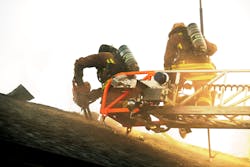Vertical Ventilation: For a More Efficient, Safer and Effective Fireground
Very few who are in the fire service will dispute the importance of controlled and coordinated ventilation. (In this author’s opinion, it is second only to proper hoseline placement.) Whatever your ventilation mission is, it’s important that ventilation is accomplished in concert with a properly placed and charged hoseline that’s ready for battle.
At residential structure fires, you can make many positive changes for victims in the structure as well as for your firefighters with coordinated, systematic ventilation. The improved visibility that’s afforded firefighters via ventilation allows them to work more efficiently, which leads to a safer fireground. Ventilation also improves the chances of victim survivability by removing the heat and smoke from their environment, thus aiding in quicker removal. A benefit of proper ventilation that often is overlooked is decreased property damage, not just from the removal of smoke and heat but from the faster extinguishment that’s afforded by their removal.
For top-floor or attic fires, your best bet for effective ventilation is vertical ventilation. Top-floor fires can happen in any type of building, and in one-story buildings, any fire is a top-floor fire. However, vertical ventilation isn’t embraced in some circles, particularly when it comes to peaked-roof ventilation; therefore, the tactic isn’t used by many departments.
I am writing to tell you that peaked-roof ventilation is an effective tactic and has been used effectively at thousands of fires over the years where conditions allow for it. Since 2010, only eight line-of-duty deaths (LODDs) were tied to ventilation efforts; three were from falls and two were from collapse. I don’t mean in any way to imply that eight LODDs isn’t a significant number, but by comparison, 126 firefighters died in the process of advancing the initial attack line during that same 11-plus-year time frame.
Firefighters, officers and incident commanders must do their best to complete a thorough size-up to determine construction type and how long the fire has been burning on the top floor. All that said, like everything that’s involved in the fire service, “always” and “never” rarely apply: Sometimes, vertical ventilation might not be a viable option.
Having a plan
Just like everything that you do in the fire service, for rooftop ventilation, you must have a plan in place, and you must practice until you can execute the plan safely and proficiently. First, you must understand building construction and fire behavior and how both of those elements affect topside operations. You must know what the fire is doing, where the fire is going and how your ventilation holes will affect the fire conditions that are on the inside.
It is imperative that you have clear assignments for your crews, so all of the members understand their responsibility when it comes to tasks and tools and how the standard operating procedures relate to the process of vertical ventilation.
Peaked-roof operations
In my home department, the second-due truck assumes topside ventilation and must be prepared to get to the roof quickly and safely. The tools and equipment that we bring to the roof vary a little based on the type of structure. Because many houses that are in my city are 12/12 pitch (with about a 45-degree pitch), they don’t allow for walking, so the topside crew works off of a roof ladder. Each firefighter has hand tools (axe, maul, 6- or 8-foot hook), and the team will bring a chainsaw, too. (Sometimes, the tools depend on the roof covering.) The officer brings the tool of choice as well as a thermal imaging camera to help to evaluate the condition of the roof. Remember, what you bring up you must bring back, so less might be more.
We always do our best to ladder the “clean” side of the structure that’s opposite the side to which the hoselines are stretched. Many factors play into our ability to ladder the clean side, including wind direction, automobiles that are parked in driveways, the layout of the structure and fire conditions. Depending on staffing for a peaked roof, we send two firefighters to the roof to make the cut while the officer monitors from the gutter line or from the base of the roof ladder.
In a perfect world, a chainsaw is best, but if it stalls or malfunctions, crews must get chopping without delay, and the crews that are making the push will be very pleased that their topside mates do exactly that. The uncommitted members of the crew or of another crew can work on getting the chainsaw running or retrieving a replacement chainsaw.
Readers might consider this is all well and good “if you run truck companies that have four-person crews.” Believe, me, I understand that a four-person crew is the exception, not necessarily the rule. Nevertheless, in short-staffed situations or in regard to departments that respond to structure fires with only one (or no) truck company, you must free up personnel to accomplish these truck-specific tasks, which allows nozzle teams to accomplish their tough mission of attacking the fire.
In this situation, it becomes even more critical to have a plan for riding and tool assignments that’s flexible enough to account for the times when you don’t have the personnel but strict enough to ensure that all of the tools and equipment that are necessary to accomplish the mission make it to the scene of the incident.
The cuts
There are several methods for roof ventilation, depending on conditions.
A trench cut largely is a defensive strategy to stop the spread of fire in a top-floor fire. Traditionally, it’s a flat-roof tactic that requires a lot of staffing and, basically, writes off part of the building.
A louver cut requires fewer crewmembers and works well on many styles of roofs. It can be done with a rotary saw or vent saw. Basically, the firefighter makes the first cut near the peak of the roof, rolling the rafters to identify their location, and then makes a cut between each of the rafters. A bottom cut then connects all of the other cuts that were made up until now. At this point in the process, you can louver the cuts open and use a hook to push in the ceiling below if there is one.
The 7,9,8 cut typically is a flat-roof cut. Often, it’s referred to as a coffin cut. The first cuts of this process are made to form a “7”; the vent team then makes cuts to form a “9”; finally, the team finishes the cuts in the shape of an “8,” or a rectangular “coffin-shape” hole. When a crew uses this technique, it’s important to overlap each cut, which allows for easier removal of the roofing materials.
Another cut that we see for vertical ventilation is a basic square cut, or the 4 x 4-foot hole that often is taught in drill school. This is a smaller version of the coffin cut: four cuts are made to size and overlap each other to aid in removal.
Cuts must be done quickly and effectively. Once you accomplish your mission of topside ventilation, it usually is best to get your crews off of the roof immediately.
Flat roofs
Vertical ventilation of flat roofs is critical to open cockloft space, to allow engines to make the push on the seat of the fire. Sometimes, our department ventilates flat roofs to take a stand against a free-burning fire and to cut off its spread.
When dealing with flat roofs, you must do a good size-up from the roof to decide where to cut. You usually can start the process by opening any natural openings on the roof, such as scuttles and skylights, if conditions warrant.
Accessing the roof
There are a few techniques for getting to the roof to vertically ventilate—for example, an extension ladder and a roof ladder, an extension ladder and two roof ladders, an aerial device and roof ladder, etc.
Using an aerial takes extra coordination and care when making transitions from aerial to roof and between the firefighter who is making the cut and the one who is at the turntable controlling the aerial.
If you have a tower ladder, you often can make the cut right out of the bucket if you tether yourself. Sometimes, this is easier than the alternative, because communication with the operator, who is close by in the bucket, is easier.
Training on different techniques and preparing for different building construction and roof types is a must for your crews. Regardless of your preferred method of peaked-roof ventilation, you should have a few options in your toolbox. The more that you know, the quicker that you can get things done on the fireground.
Sean Eagen will present “Developing Today’s Truck Company Culture” and co-present “Managing Everyday Incidents” at Firehouse Expo. To register, visit firehouseexpo.com.
About the Author

Sean Eagen
Sean Eagen is a 28-year veteran of the Buffalo, NY, Fire Department. He currently is the captain of Truck 4. Eagen also is an instructor for the New York State Office of Fire Prevention and Control Special Operations Branch. He was a regular presenter at Firehouse's conferences.
